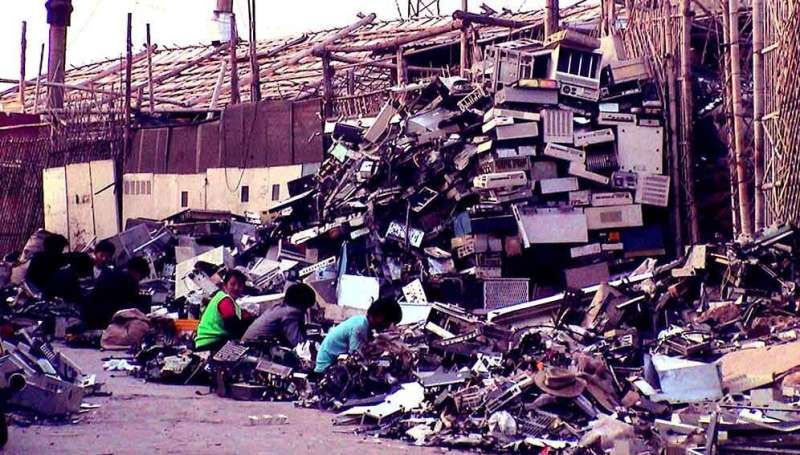A typical e-waste recycling operation. Workers are exposed to heavy metals, with research showing waste pickers have high levels of cadmium in their blood. Credit: Baselactionnetwork. (CC BY-ND 2.0)
Waste pickers exposed to discarded electronics, aluminum and metal cans have up to four times higher levels of the toxic heavy metal cadmium in their blood than the wider population, a study has found.
Researchers in Brazil found that salvagers and workers at recycling facilities—known as waste pickers—who previously worked in another occupation had lower cadmium levels, suggesting that length of exposure and heavy metal concentration levels are linked.
Scientists compared the levels of cadmium, mercury and lead in the blood of 226 workers from four recycling material cooperatives at recycling sorting facilities in the metropolitan area of São Paulo, with 653 people who do not work in the industry.
These cooperatives are considered waste management agents and are contracted by municipalities or companies to sort plastic, glass, paper, and aluminum or other metal cans. The recycling sorting sites also contain electronic waste, researchers say.
The study found 0.47 micrograms of cadmium per liter of blood among recyclers, compared with 0.12 micrograms among other workers. Lead levels were about 10 micrograms higher among waste workers.
A United Nations Children's Fund (UNICEF) study found that the children of waste pickers are also exposed to heavy metals, such as lead.
Parents whose jobs involve recycling batteries can bring contaminated dust home on their clothes, hair, hands and shoes. One in three children—about 800 million worldwide—have high levels of lead in their blood, UNICEF says.
Cadmium, lead and mercury are highly toxic and carcinogenic. High levels of cadmium and lead can have neurological, digestive and cardiovascular impacts, while mercury is associated with systemic toxicity in the kidneys and central nervous system.
Maria de Fátima Moreira, from the Center for the Study of Occupational Health and Human Ecology at Brazil's National School of Public Health, tells SciDev.Net that the study highlights the dangers that waste pickers are exposed to. But, she warns that the results may not reflect the circumstances of waste pickers across the whole of Brazil, or of those in other developing countries.
"There are great differences among groups of waste pickers inside and outside Brazil, especially between those who work in cooperatives and those in recycling industries," Moreira tells SciDev.Net.
"For an ideal comparison, both populations should be as similar as possible in socioeconomic terms and processes of work."
Variables
Toxicologist Eduardo De Capitani, from the University of Campinas, says that researchers need to consider factors beyond occupation that could affect heavy metal concentrations in blood.
"An evaluation cannot be made considering only the activity," says De Capitani, who was not involved in the study, published in Reports in Public Health.
The levels of metals found in the recyclers' blood show the existence of an uncontrolled exposure. But, the effects are unpredictable.
Moreira agrees. "In chronic exposure, the metals accumulate over time and their harmful effects will only be seen after many years," she tells SciDev.Net. Moreira says the best measure of exposure to cadmium and mercury is urine, as "urine is more representative of what happens in this absorption."
According to the Global Alliance of Waste Pickers, there are more than two million such workers in Latin America, with 600,000 in Brazil alone. In China, there are almost 2.5 million and in India, up to four million people are estimated to work in the waste collection sector.
De Capitani believes the study's results may be applicable in other contexts, provided there are similar factors, such as food consumption and types of waste. "There's no point in comparing São Paulo to small cities with little garbage of the same type," he says.
More information: Mariana Maleronka Ferron et al. Cadmium, lead and mercury in the blood of workers from recycling sorting facilities in São Paulo, Brazil, Reports in Public Health (2020). DOI: 10.1590/0102-311X00072119
Provided by SciDev.Net























